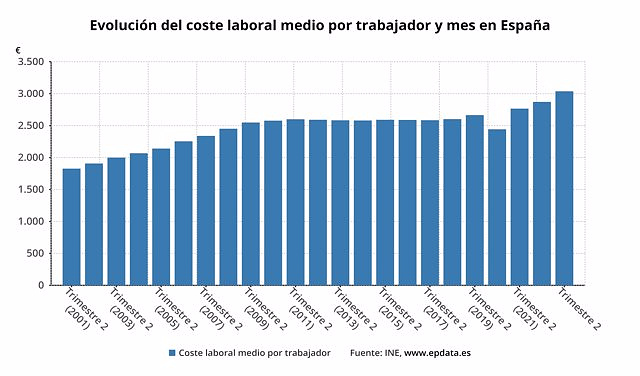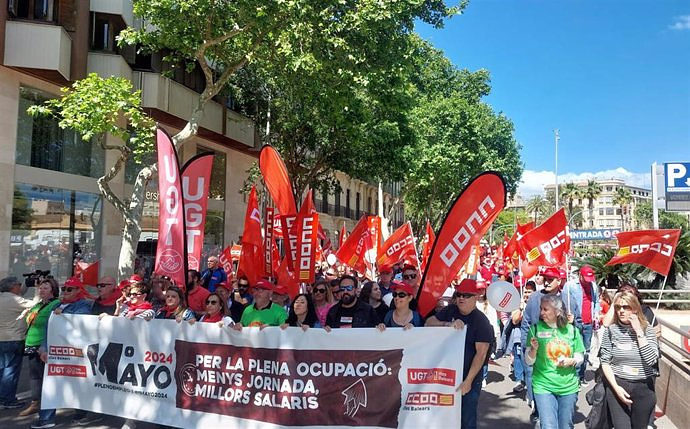Job vacancies exceed 148,000, most in the services sector
The average labor cost per worker per month (which includes salaries and social contributions) shot up by 5.8% in the second quarter of the year compared to the same period in 2022 and exceeded 3,000 euros per worker per month for the first time. standing at 3,037.52 euros, the National Institute of Statistics (INE) reported this Friday.
This increase in labor costs, which has accumulated ten consecutive quarters of increases, is four tenths lower than that registered in the first quarter (6.2%).
The labor cost is made up of the salary cost and other costs. Between April and June, salaries (all remuneration, both in cash and in kind) rose 5% year-on-year in gross terms, reaching an average of 2,262.63 euros per worker per month, the highest figure in a second quarter since the beginning of the series, in 2000.
Excluding the variable factor of salaries (extraordinary and late payments) we obtain the ordinary salary cost, which in the second quarter of the year rose by 5.5%, to 1,907.68 euros per month.
Other costs (non-wage costs) totaled 774.89 euros per worker per month in the second quarter of the year, with a year-on-year increase of 8%. The most important component of the other costs are the mandatory Social Security contributions, which amounted to 717.58 euros per month, 7.8% more than in the second quarter of 2022.
The second important element of other costs is non-salary benefits, which increased by 9.1% year-on-year, due to the increase in severance payments. For their part, subsidies and bonuses increased by 7% year-on-year between April and June 2023.
According to the INE, the labor cost per effective hour rose by 6.5% in annual rate in the second quarter of the year, to 23.22 euros, due to the 0.7% decrease in effective working hours. For its part, the labor cost per hour paid increased by 5.5% year-on-year, to 20.02 euros.
The INE also provides calendar-corrected and seasonally adjusted data for this statistic. According to this series, the labor cost per worker rose by 5.9% year-on-year in the second quarter of 2023, two tenths more than in the previous quarter. With this increase, there are eleven consecutive quarters of year-on-year increases in the corrected series.
In quarter-on-quarter terms (second quarter over the first quarter of the year), the labor cost per worker per month increased by 1.2% in data corrected for seasonality and calendar, half of what it grew between January and March.
30.1 EFFECTIVE HOURS OF WORK PER WEEK
During the second quarter of 2023, the average agreed weekly working day, jointly considering full-time and part-time, was 34.8 hours. Of these, on average, 4.9 hours per week were lost, of which 2.5 hours were not worked due to vacations and holidays; 1.9 hours are due to sick leave due to temporary disability; 0.3 hours for maternity and paternity leaves, and another 0.3 hours for other leaves, strikes, and technical, economic, organizational, production and/or force majeure reasons.
If overtime is added and losses are subtracted, the effective working hours per week are reduced to 30.1.
Depending on the type of shift, the salary difference between full-time and part-time workers is 5.84 euros per hour, but it must be taken into account that full-time workers practically double the hours of effective work performed by part-time employees. (33.4 hours vs. 18.8 hours).
According to the INE, the services sector had the largest year-on-year increase in labor costs in the second quarter of the year, 6.3%, up to 2,953.49 euros per worker per month, while also leading the rise in salaries. with an increase of 5.6%, up to 2,210.24 euros per month.
HOSPITALITY SALARY GROWS BY 7.7% IN THE LAST YEAR
The highest annual wage growth in the second quarter occurred in administrative activities (7.8%), hospitality (7.7%) and transportation and storage (7.2%), while the supply of electricity and gas and water and waste supply cut their salaries by 7.4% and 2.1%, respectively.
Specifically, the salary for administrative activities was 1,543.1 euros per month and for hospitality, 1,339 euros. Despite both activities having the largest annual increases in salary costs in the second quarter, their amount is the lowest of all activity sections.
On the opposite side, with the highest salaries, are the supply of electricity (5,536.9 euros per worker and month); financial and insurance activities (4,346.2 euros); information and communications (3,267.9 euros); extractive industries (3,146.5 euros), and Public Administration (3,030.3 euros per worker and month).
Regarding the total labor cost, the largest year-on-year increases in the second quarter were recorded in the extractive industries, with an increase of 10.6%, up to 4,575.9 euros per worker per month, and in the hospitality industry, with an increase of 8.7%, up to 1,843 euros. The only year-on-year decrease in labor costs was recorded in energy supply, with a decline of 5.4%, to 6,968.9 euros per worker per month.
By autonomous community, the highest labor costs were recorded in Madrid (3,562.1 euros per worker per month), the Basque Country (3,378.5 euros), Navarra (3,334 euros) and Catalonia (3,313.7 euros). On the other hand, the lowest were in Extremadura and the Canary Islands, with 2,409.1 and 2,584.3 euros, respectively.
Labor costs increased in all regions in the second quarter of 2023 year-on-year. The Balearic Islands and Navarra presented the largest increases, of 10.9% and 8.3%, respectively, while Extremadura and the Valencian Community registered the most moderate increases, with increases of 3.5% and 3.6%, respectively.
MORE THAN 148,000 VACANCIES
The INE has also reported that in the second quarter of 2023, 148,091 job vacancies were registered, of which 88.5% belonged to the services sector.
A job vacancy is understood as a newly created job that is not filled or is about to become vacant and for which the employer is taking active steps to find a candidate from outside the company.
93.5% of the companies questioned by the INE responded that they had no vacancies to fill between April and June because they did not need additional workers.
Catalonia and Madrid had the highest number of vacancies in the second quarter, with 30,800 and 29,424, respectively, while Extremadura and La Rioja presented the lowest figures, with 430 and 561 vacancies, respectively.

 Exploring Cardano: Inner Workings and Advantages of this Cryptocurrency
Exploring Cardano: Inner Workings and Advantages of this Cryptocurrency Seville.- Economy.- Innova.- STSA inaugurates its new painting and sealing hangar in San Pablo, for 18 million
Seville.- Economy.- Innova.- STSA inaugurates its new painting and sealing hangar in San Pablo, for 18 million Innova.- More than 300 volunteers join the Andalucía Compromiso Digital network in one month to facilitate access to ICT
Innova.- More than 300 volunteers join the Andalucía Compromiso Digital network in one month to facilitate access to ICT Innova.-AMP.- Ayesa acquires 51% of Sadiel, which will create new technological engineering products and expand markets
Innova.-AMP.- Ayesa acquires 51% of Sadiel, which will create new technological engineering products and expand markets AstraZeneca admits that its Covid vaccine can cause side effects such as thrombosis in "very rare cases"
AstraZeneca admits that its Covid vaccine can cause side effects such as thrombosis in "very rare cases" The PP signs the director of the cabinet of the governor of the Bank of Spain for its list for the European elections
The PP signs the director of the cabinet of the governor of the Bank of Spain for its list for the European elections Illa does not rule out agreeing with Junts after the Catalans if they do not prioritize independence
Illa does not rule out agreeing with Junts after the Catalans if they do not prioritize independence Los Angeles Police begin to dismantle the encampment at the University of California
Los Angeles Police begin to dismantle the encampment at the University of California How Blockchain in being used to shape the future
How Blockchain in being used to shape the future Not just BTC and ETH: Here Are Some More Interesting Coins Worth Focusing on
Not just BTC and ETH: Here Are Some More Interesting Coins Worth Focusing on UPV students design an app that helps improve the ventilation of homes in the face of high temperatures
UPV students design an app that helps improve the ventilation of homes in the face of high temperatures Ivace and promotes a less invasive device for the early detection of prostate cancer
Ivace and promotes a less invasive device for the early detection of prostate cancer Valencia unanimously approves the ordinance to allocate spaces to test innovative initiatives
Valencia unanimously approves the ordinance to allocate spaces to test innovative initiatives UPV researchers promote a paid master's degree as a "talent factory" in integrated photonics
UPV researchers promote a paid master's degree as a "talent factory" in integrated photonics A million people demonstrate in France against Macron's pension reform
A million people demonstrate in France against Macron's pension reform Russia launches several missiles against "critical infrastructure" in the city of Zaporizhia
Russia launches several missiles against "critical infrastructure" in the city of Zaporizhia A "procession" remembers the dead of the Calabria shipwreck as bodies continue to wash up on the shore
A "procession" remembers the dead of the Calabria shipwreck as bodies continue to wash up on the shore Prison sentences handed down for three prominent Hong Kong pro-democracy activists
Prison sentences handed down for three prominent Hong Kong pro-democracy activists ETH continues to leave trading platforms, Ethereum balance on exchanges lowest in 3 years
ETH continues to leave trading platforms, Ethereum balance on exchanges lowest in 3 years Investors invest $450 million in Consensys, Ethereum incubator now valued at $7 billion
Investors invest $450 million in Consensys, Ethereum incubator now valued at $7 billion Alchemy Integrates Ethereum L2 Product Starknet to Enhance Web3 Scalability at a Price 100x Lower Than L1 Fees
Alchemy Integrates Ethereum L2 Product Starknet to Enhance Web3 Scalability at a Price 100x Lower Than L1 Fees Mining Report: Bitcoin's Electricity Consumption Declines by 25% in Q1 2022
Mining Report: Bitcoin's Electricity Consumption Declines by 25% in Q1 2022 Oil-to-Bitcoin Mining Firm Crusoe Energy Systems Raised $505 Million
Oil-to-Bitcoin Mining Firm Crusoe Energy Systems Raised $505 Million Microbt reveals the latest Bitcoin mining rigs -- Machines produce up to 126 TH/s with custom 5nm chip design
Microbt reveals the latest Bitcoin mining rigs -- Machines produce up to 126 TH/s with custom 5nm chip design Bitcoin's Mining Difficulty Hits a Lifetime High, With More Than 90% of BTC Supply Issued
Bitcoin's Mining Difficulty Hits a Lifetime High, With More Than 90% of BTC Supply Issued The Biggest Movers are Near, EOS, and RUNE during Friday's Selloff
The Biggest Movers are Near, EOS, and RUNE during Friday's Selloff Global Markets Spooked by a Hawkish Fed and Covid, Stocks and Crypto Gain After Musk Buys Twitter
Global Markets Spooked by a Hawkish Fed and Covid, Stocks and Crypto Gain After Musk Buys Twitter Bitso to offset carbon emissions from the Trading Platform's ERC20, ETH, and BTC Transactions
Bitso to offset carbon emissions from the Trading Platform's ERC20, ETH, and BTC Transactions Draftkings Announces 2022 College Hoops NFT Selection for March Madness
Draftkings Announces 2022 College Hoops NFT Selection for March Madness























